Elgin National Watch Company, Elgin, Illinois
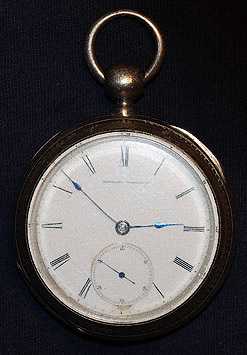
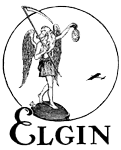 John C. Adams, Chicago watchmaker and timekeeper for the railroad serving the Chicago area, along with Benjamin W. Raymond, past Chicago mayor and member of the board of directors of the Chicago and Galena Union Railroad, promoted the construction of a watch factory in the West. The National Watch Company was first incorporated in Chicago, Illinois, in August 1864. The incorporators included Benjamin W. Raymond, past Chicago mayor, Howard Z. Culver, Thomas W. Dickenson, George M. Wheeler, Philip Carpenter, W. Robbins and Edward H. Williams. Several key watchmakers were recruited from the American Waltham Watch Co. in Waltham, Massachusetts. The factory in Elgin, Illinois, thirty miles northwest of Chicago, was completed in 1866.
John C. Adams, Chicago watchmaker and timekeeper for the railroad serving the Chicago area, along with Benjamin W. Raymond, past Chicago mayor and member of the board of directors of the Chicago and Galena Union Railroad, promoted the construction of a watch factory in the West. The National Watch Company was first incorporated in Chicago, Illinois, in August 1864. The incorporators included Benjamin W. Raymond, past Chicago mayor, Howard Z. Culver, Thomas W. Dickenson, George M. Wheeler, Philip Carpenter, W. Robbins and Edward H. Williams. Several key watchmakers were recruited from the American Waltham Watch Co. in Waltham, Massachusetts. The factory in Elgin, Illinois, thirty miles northwest of Chicago, was completed in 1866.
The first movement, completed in April 1867, was named the B.W. Raymond in honor of Benjamin W. Raymond, the company's president. The watch was an 18-size, 15-jewels, key wind, key set, full plate, quick train and straight line escapement design adjusted to temperature (later assigned grade 69). The second grade introduced was the H. Z. Culver in July 1867, also a 15-jewel, adjusted, high grade, full plate movement. The H. H. Taylor grade was introduced in November 1867, also an adjusted 15-jewel, high grade, full plate movement advertised for use by railroad men.
In 1867 some of the B.W. Raymond grade 15-jewels movements were built with Pennsylvania Rail Road on the dial for service on the Pennsylvania Rail Road.
By 1870 the plant was turning out 25,000 watches each year and employed nearly 300 men and 200 women. During the early part of the 1870's the factory was enlarged. In June 1873 the first stem-wind B. W. Raymond movement was placed on the market. By late 1873 the product line included at least 14 different grades and production was estimated at 100,000 movements per year.
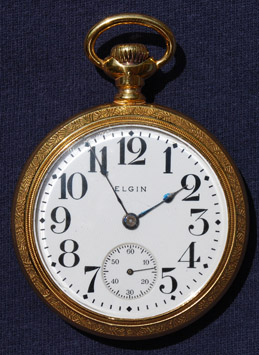 The National Watch Company, like the American Waltham Watch Company, relied on jewelry wholesalers to distribute the movements it produced. Elgin did not produce watch cases, retail customers would pick out a watch movement and a watch case, a jeweler would fit them together. The National Watch Company employed representatives to help sell the product to wholesalers, and ran advertisements in magazines and newspapers to purchase their movements through local jewelry stores. They also produced the Elgin Almanac from 1871 to 1876 to help advertise watches.
The National Watch Company, like the American Waltham Watch Company, relied on jewelry wholesalers to distribute the movements it produced. Elgin did not produce watch cases, retail customers would pick out a watch movement and a watch case, a jeweler would fit them together. The National Watch Company employed representatives to help sell the product to wholesalers, and ran advertisements in magazines and newspapers to purchase their movements through local jewelry stores. They also produced the Elgin Almanac from 1871 to 1876 to help advertise watches.
The company officially changed its name to the Elgin National Watch Company in May 1874, as the Elgin name had come into common usage for their watches.
During the mid-1870's the company developed a lower priced line of watches. The 18-size and 16-size watch models were redesigned and smaller size watches for general use were introduced. Prices were also reduced resulting in increased demand.
Elgin became best known for producing the "working man's" mid-grade watches, however, they also produced a number of high grade watches. Elgin watch grades identify the level of quality to which they are finished. Elgin assigned a grade number to a movement of a specific size, jeweling and finish. If a change was made a different grade number would be assigned. Elgin also assigned a name, such as B W. Raymond, to a range of grade numbers of various sizes and jeweling, but finished to the same level of quality.
18 Size Movements Manufactured for Railroad Service
Elgin's first movement, completed in April 1867, was the B.W. Raymond grade, an 18-size, 15-jewels, key wind, key set, full plate, quick train and straight line escapement design adjusted to temperature (later assigned grade 69). The second grade introduced was the H. Z. Culver in July 1867 (later assigned grade 62), also a 15-jewel, adjusted, high grade, full plate movement. The H. H. Taylor grade was introduced in November 1867 (later assigned grade 58), also an adjusted 15-jewel, high grade, full plate movement. Marked "adjusted", all three grades were advertised for use by railroad men.
In June 1873 the first stem-wind B. W. Raymond movement was placed on the market.
An 1892 catalog lists 18-size grades B. W. Raymond, H. H. Taylor, NO. 33, No. 76, No. 126, No. 125, No. 124 and No. 123 as 15-jewels, adjusted and with a patent regulator, meeting railroad service requirements at the time.
An 1896 catalog lists 18-size grades No. 150 (open face, 21-jewel), No. 149 (hunting, 21-jewel), No. 166 (open face, 17-jewel), No. 164 (hunting, 17-jewel), No. 165 (open face, 17-jewel), No. 163 (hunting, 17-jewel), B. W. Raymond (open face or hunting, 17 jewels), No. 148 (open face, 17-jewel), No. 144 (hunting, 17-jewel), No. 147 (open face 17-jewel), No. 143 (hunting, 17-jewel), as adjusted and with a patent regulator, meeting railroad service requirements at the time.
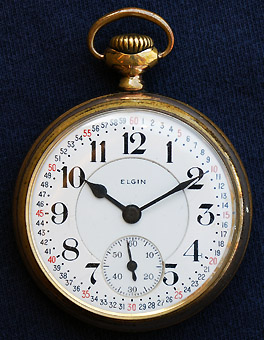 A 1903 catalog listed 18-size Veritas (No. 214 open face 23-jewel and No. 239 open face 21-jewel), Father Time (open face and hunting 21-jewel), No. 149 (21-jewel hunting case only), and B. W. Raymond (No. 240 open face 19-jewel, and open face and hunting 17-jewel) as adjusted to temperature, isochronism and positions, with a patent regulator and lever set, meeting railroad service requirements at the time.
A 1903 catalog listed 18-size Veritas (No. 214 open face 23-jewel and No. 239 open face 21-jewel), Father Time (open face and hunting 21-jewel), No. 149 (21-jewel hunting case only), and B. W. Raymond (No. 240 open face 19-jewel, and open face and hunting 17-jewel) as adjusted to temperature, isochronism and positions, with a patent regulator and lever set, meeting railroad service requirements at the time.
A 1913-14 catalog listed 18-size Veritas (21 and 23-jewel), Father Time (21-jewel), B. W. Raymond (21, 19 and 17-jewel), and No. 349 (21-jewel) as adjusted to temperature, isochronism and five positions, with a patent regulator and lever set, meeting railroad service requirements.
16 Size Movements Manufactured for Railroad Service
An 1892 catalog lists several 16-size grades as meeting railroad service requirements at the time, these were grades No. 91 (21-jewel), No. 72 (21-jewel), No. 108 (15-jewel) and No. 107 (15-jewels), No. 4 (15-jewel) and No. 3 (15-jewel).
An 1896 catalog lists 16-size grades listed as meeting railroad service requirements were grades No. 162 (open face, 21-jewel), No. 156 (hunting, 21-jewel), No. 161 (open face, 17-jewel), No. 155 (hunting, 17-jewel), No. 160 (open face, 17-jewel), No. 154 (hunting, 17-jewel), No. 159 (open face, 17-jewel), and No. 153 (hunting, 17-jewel).
A 1903 catalog listed 16-size grades similarly listed were grades No. 162 (21-jewel open face), No. 156 (21-jewel hunting), No. 155 (17-jewel hunting), No. 246 (17-jewel open face). A 1904 advertisement listed the 16-size No. 270 (21-jewel open face) and No. 280 (17-jewel open face), as adjusted to temperature, isochronism and positions, with a patent regulator and lever set, meeting railroad service requirements.
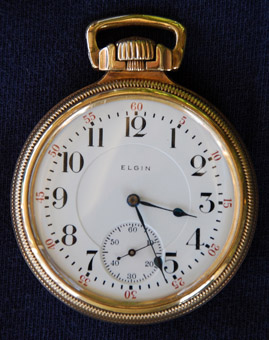 A 1913-14 catalog listed 16-size grades similarly listed were grades Veritas (21 and 23-jewel), Father Time (21-jewel), and B. W. Raymond (21, 19 and 17-jewel) as meeting railroad service requirements.
A 1913-14 catalog listed 16-size grades similarly listed were grades Veritas (21 and 23-jewel), Father Time (21-jewel), and B. W. Raymond (21, 19 and 17-jewel) as meeting railroad service requirements.
The company built the Elgin National Watch Company Observatory in 1910 to help maintain scientifically precise times in their watches. Elgin shipped their first wrist watch in 1910.
During World War II all civilian manufacturing was halted and the company moved into the defense industry, manufacturing military watches, chronometers, fuses for artillery shells, aircraft instruments and sapphire bearings used for aiming cannons.
In 1960 Elgin introduced the first American made wrist watch to be qualified for railroad service, the grade 730A, also named B.W. Raymond.
Over time additional plants were operated in Elgin, Aurora, Illinois and Lincoln, Nebraska. The original factory in Elgin closed in 1964, after having produced half of the total number of pocket watches manufactured in the United States (dollar-type not included). In 1964 the company relocated most manufacturing operations to a brand new plant in Blaney, South Carolina, which renamed itself Elgin, South Carolina.
All US manufacturing was discontinued in 1968, and the rights to the name "Elgin" were sold and subsequently resold multiple times over the years.
Elgin railroad grade watches (not all were railroad approved)
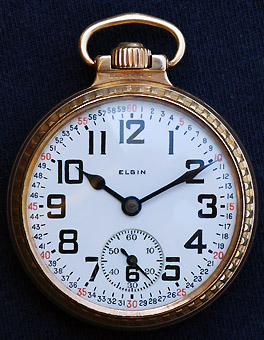 The following is from a list of railroad grade watches which is generally attributed Webb C. Ball. List appears to be from around 1908-1909. Not all of these were railroad approved even though all are railroad grade.
The following is from a list of railroad grade watches which is generally attributed Webb C. Ball. List appears to be from around 1908-1909. Not all of these were railroad approved even though all are railroad grade.
- 18 Size: “Pennsylvania Railroad Co.” on dial, 15J & 17J, key wind and set, first model “B.W. Raymond”
- “No. 349,” seventh model, 17-21J
- Veritas, 21-23J
- B.W. Raymond, 17-21J
- Father Time, 21J
- 16 Size: Grades 162, 270, 280, or 342 marked on back plate, 17-21J
- Veritas, 21-23J
- Father Time, 21J
- Paillard Non-Magnetic, 19-23J
- 571, 21J or 572, 19J
- All wind indicator models
Elgin Production Dates by Serial Number
Note: These are approximate dates, actual dates may vary by years. The serial number being referred to is the serial number on the movement of the watch, not the case.
| 1867 - 9,000 | 1885 - 1,855,000 | 1903 - 10,000,000 | 1921 - 24,000,000 | 1939 - 38,200,000 |
| 1868 - 25,000 | 1886 - 2,000,000 | 1904 - 11,000,000 | 1922 - 25,100,000 | 1940 - 39,100,000 |
| 1869 - 40,000 | 1887 - 2,500,000 | 1905 - 12,000,000 | 1923 - 26,050,000 | 1941 - 40,200,000 |
| 1870 - 50,000 | 1888 - 3,000,000 | 1906 - 12,500,000 | 1924 - 27,000,000 | 1942 - 41,100,000 |
| 1871 - 185,000 | 1889 - 3,500,000 | 1907 - 13,000,000 | 1925 - 28,421,000 | 1943 - 42,000,000 |
| 1872 - 201,000 | 1890 - 4,000,000 | 1908 - 13,500,000 | 1926 - 29,100,000 | 1944 - 42,500,000 |
| 1873 - 325,000 | 1891 - 4,449,000 | 1909 - 14,000,000 | 1927 - 30,050,000 | 1945 - 43,200,000 |
| 1874 - 400,000 | 1892 - 4,600,000 | 1910 - 15,000,000 | 1928 - 31,599,000 | 1946 - 44,000,000 |
| 1875 - 430,000 | 1893 - 5,000,000 | 1911 - 16,000,000 | 1929 - 32,000,000 | 1947 - 45,000,000 |
| 1876 - 480,000 | 1894 - 5,500,000 | 1912 - 17,000,000 | 1930 - 32,599,000 | 1948 - 46,000,000 |
| 1877 - 520,000 | 1895 - 6,000,000 | 1913 - 17,339,000 | 1931 - 33,000,000 | 1949 - 47,000,000 |
| 1878 - 570,000 | 1896 - 6,500,000 | 1914 - 18,000,000 | 1932 - 33,700,000 | 1950 - 48,000,000 |
| 1879 - 625,000 | 1897 - 7,000,000 | 1915 - 18,587,000 | 1933 - 34,558,000 | 1951 - 50,000,000 |
| 1880 - 750,000 | 1898 - 7,494,000 | 1916 - 19,000,000 | 1934 - 35,000,000 | 1952 - 52,000,000 |
| 1881 - 900,000 | 1899 - 8,000,000 | 1917 - 20,031,000 | 1935 - 35,650,000 | 1953 - 53,500,000 |
| 1882 - 1,000,000 | 1900 - 9,000,000 | 1918 - 21,000,000 | 1936 - 36,200,000 | 1954 - 54,000,000 |
| 1883 - 1,250,000 | 1901 - 9,300,000 | 1919 - 22,000,000 | 1937 - 36,978,000 | 1955 - 54,500,000 |
| 1884 - 1,500,000 | 1902 - 9,600,000 | 1920 - 23,000,000 | 1938 - 37,900,000 | 1956 - 55,000,000 |
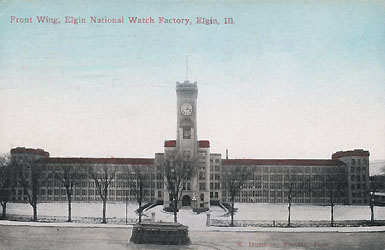 |
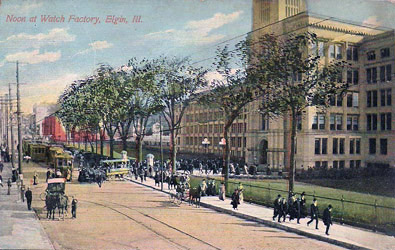 |
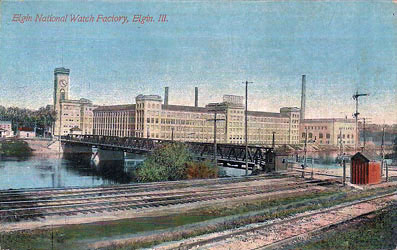 |
 |
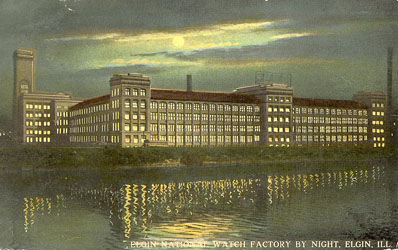 |
 |
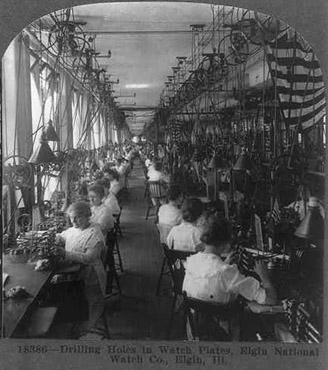 Links to other sites for additional information:
Links to other sites for additional information:
Elgin Watch Collectors Site - Information on watches from the Elgin National Watch Company, its history and technical details.
Pocket Watch Database: - Serial number lookup and information for Hamilton, South Bend, Illinois, Rockford, Waltham & Elgin.
For Additional Reading:
Abbott, Henry G. The Watch Factories of America Past and Present: A complete history of Watch Making in America, from 1809 to 1888 Inclusive. Geo. K Hazlitt & Co. Chicago, 1888, reprinted by Forgotten Books, Lexington, KY, 2012.
Alft, E. C. and Briska, William H. Elgin Time: A History of the Elgin National Watch Company. Elgin Historical Society, 2003, Elgin, Illinois. ISBN 0-943963-94-X
Erhardt, Roy and William "Bill" Meggers Jr., American Pocket Watches: Identification and Price Guide Beginning to End, Heart of America Press, Kansas City, MO, 1987.
Ehrhardt, Roy, Elgin Watch Company: Identification and Price Guide. Heart of America Press, 1976, Kansas City, Missouri. ISBN 0-913902-09-S
American Waltham Aurora Ball Columbus Elgin National Hamilton Hampden E.Howard Illinois Peoria Rockford South Bend Seth Thomas U.S.Marion U.S.Waltham
Sharing A Heritage Railroad History Train Technology Railroad Operation Railroad Time Museums & Heritage Railroads Railroads Today
